A Nostalgic Look Back At Movie Theater Candy + Concession Stands
A brief history of cinema refreshments + the origins of your favorite vintage sweets...
A few weeks ago, I wrote about Why We Eat Popcorn at Movie Theaters.
More recently, I’ve been working on a series surrounding the history of eating and drinking while watching movies. From the earliest cinema screenings to dine-in movie theater chains, there’s a lot to unpack. Today, I bring you the next installment of this series: Candy.
(Psst… Read to the end to vote for your favorite cinema sweet treat!)
Disclaimer: Film Flavor is a newsletter written for entertainment purposes only. While I do my best to write meaningful posts with good intentions and cite sources when I have the bandwidth, I do not have the capacity nor the expertise to fact-check research as a trained professional journalist would. Despite my best efforts, the Film Flavor newsletter may contain omissions, errors, or mistakes and cannot be relied upon for accuracy or correctness. Additionally, I am not a chef, doctor, nutritionist, or food professional, and it is the responsibility of the reader to consult qualified professionals and use good judgement to decide whether the ingredients, foods, drinks, recipes, and cooking instructions mentioned within Film Flavor are safe to use, follow, or consume. The Film Flavor newsletter does not contain any professional advice or guidance and its contents should not be considered as such. Read the full Film Flavor disclaimer on the Film Flavor About Page, here. Thank you!
Popcorn vs Candy

As we covered in Part One: The History of Popcorn at the Cinema, movie theaters didn’t originally allow food or concessions of any kind. Moviegoers were clamoring to bring snacks in, but cinemas held onto their strict no-snack rules until the Great Depression. With financial hardship sweeping the globe, theater owners, desperate to lure in paying customers, finally conceded and began offering popcorn.
In the 1930s, popcorn machines were relatively mobile and could be brought into existing theaters, no renovations necessary. Candy and other more involved snacks, on the other hand, proved to be more of a challenge. And while people loved their popcorn, customers also had a sweet tooth.
Some theaters opted to have a candy and ice cream salesman on the floor, baseball stadium-style, as is depicted in the 1988 Italian film Cinema Paradiso (pictured below.)
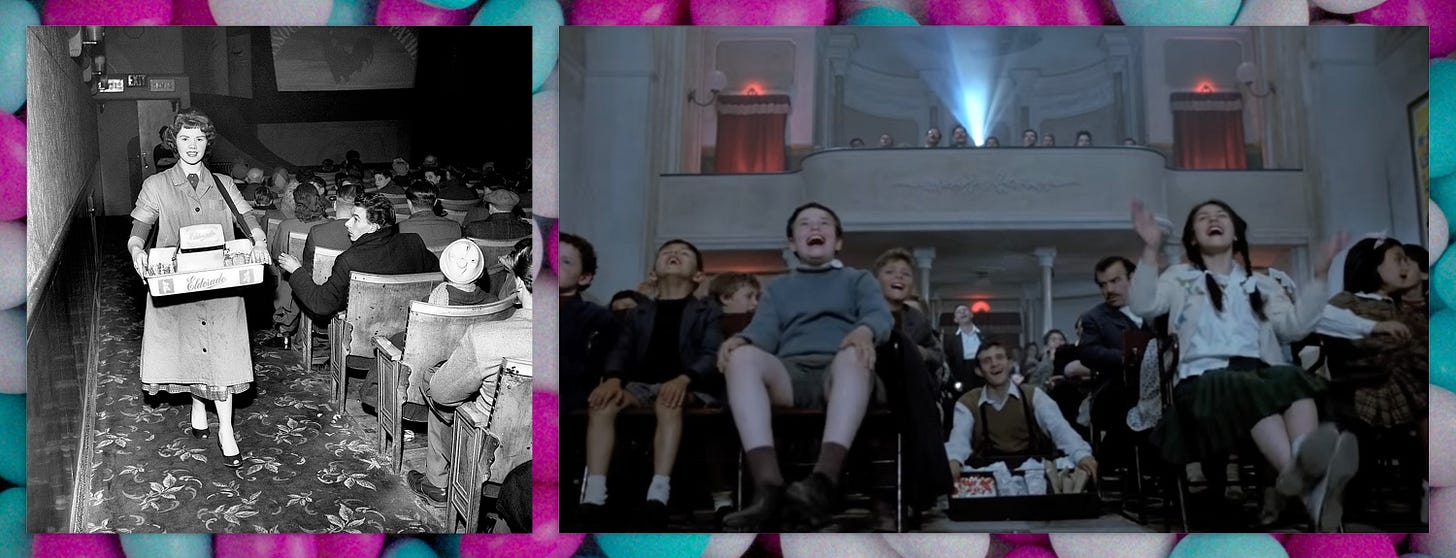
The early days of candy dispensers, trolley carts, and simply trays filled with candy being brought to your seat sure do sound whimsical. But movie theaters wanted to maximize refreshment sales. Enter: The Concession Stand.
The Concession Stand Emerges
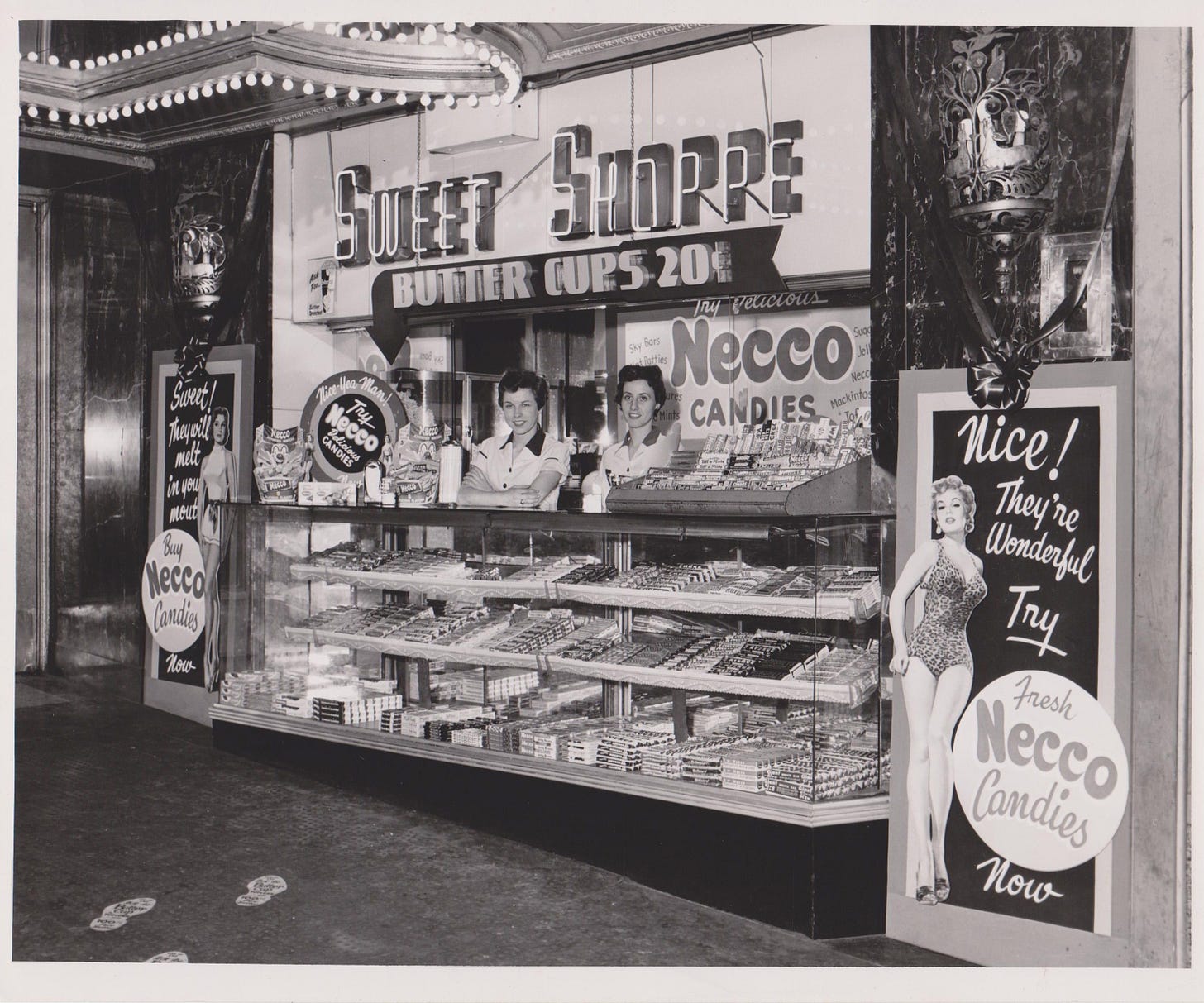
Movie theaters built in the 1930s began factoring in candy counters and concession stands into their architectural plans. During this time, while some theaters opted to offer homemade sweets like caramel apples and bonbons, candies like Baby Ruths, Sno-Caps, Goobers, Necco Wafers, Raisinets, and Milk Duds were booming in popularity.
A Piece of Red Vines Trivia
Though more controversial today, black licorice was still a popular treat in the early 20th century. When making the 1925 silent comedy The Gold Rush, Charlie Chaplin thought it would be a hoot to eat a shoe on-screen during a starving moment. Chaplin asked the American Licorice Company to make a boot out of licorice, and they obliged.
Eventually, the company began producing a licorice-like red candy that came to be known as Red Vines, the sweets we all know and love today. (In fact, Red Vines are allegedly the most popular movie theater candy on the west coast.)
New Candy Brands Hit The Scene
An in-theater advertisement for Hollywood candy bars at the concession stand, courtesy of Retro Video Vault
During World War II, sugar was rationed (at least in the U.S.A.) and popcorn became the reigning champion of movie food. Luckily, with the end of the war came a resurgence in sugar, and candies were on the rebound.
By the 1950s, sipping sickly sweet soda pops and sharing candies under the dim glow of film projectors was commonplace. Iconic new confections like M&Ms and Junior Mints (named after a popular broadway show and Shirley Temple-radio show, Junior Miss) took the concession stand by storm.
As astute Mad Men viewers will already have guessed, the 1960s and 1970s ushered in new marketing techniques, like combo deals, free refills, and discount coupons, like those pictured below.

Judging by some pre-show featurettes advertising the “refreshment counter,” some sophisticated subliminal techniques could have been at a play. (Just hit play below and listen to this song!)
While popcorn coupons and pre-show advertisements may have been driving folks to the concession stand, movie theaters were almost certainly banking on patrons catching a glimpse of those colorful boxes of mouth-watering candy through the glass counter case and adding a few to each order.
Why Does Movie Theater Candy Come in Boxes?

When you buy candy at a drug store, bodega, or grocery store, sweet treats are most often sold in bags. So, why are your Sour Patch Kids sold in boxes at the movie theater?
For one, boxes are easier to re-close. If you bought candy in a plastic bag or wrapper, one could only imagine how difficult it would be to pass candies to your friend four seats down in a dim theater without spilling or creating a noisy disturbance.
Perhaps more interestingly, candy bags in drug stores and the like are often hung on metal pegs. In movie theaters, the candy sits on shelves within a glass case. Compared to limp bags, boxed candy packaging provides a quick, clear display of the candy names and offerings, making it easier for folks waiting on the concession stand line to see what snacks are for sale.
In fact, the current branding of the miniature chocolate nonpareils Sno-Caps, one of the first movie theater candies to be sold in a box, is very similar to its earlier looks. Given Sno-Caps are some of the most-loved movie theater candies today, “if it ain’t broke, don’t fix it” is the lesson I’m choosing to glean from this.
Modern Concession Stands
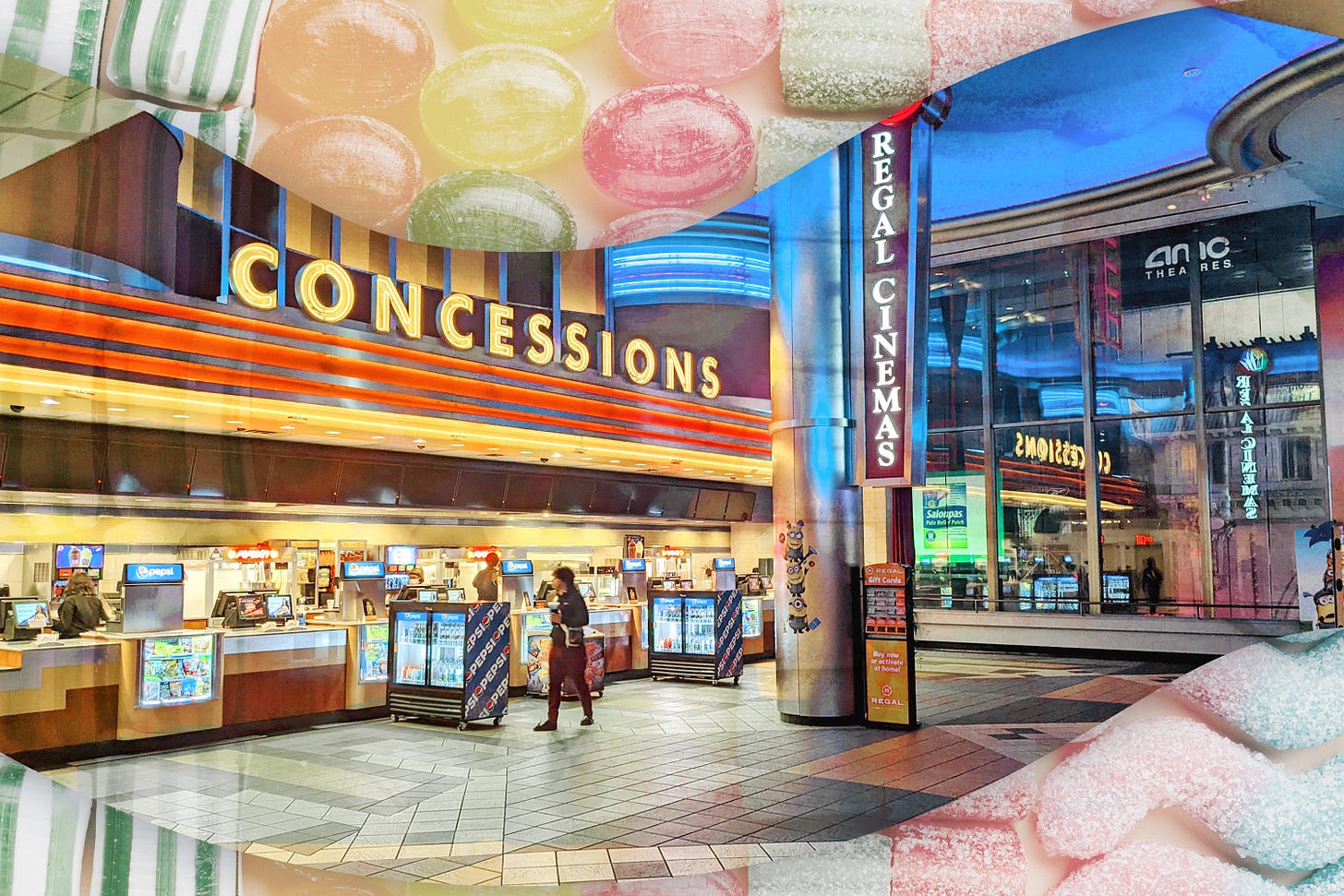
I’m not entirely certain why glass candy cases still dominate concession stand design today. Given this design dates back almost a hundred years, the design could be seen as traditional.
Whenever I walk into a movie theater where candy is displayed in an unorthodox manner (ex: bags of candy are hung on metal poles, a maze of cubicle-height walls displaying chocolate bars lining the concessions queue), it feels like I’m in a store rather than a cinema lobby.
I’m curious if others feel the same. My hypothesis? That “magic of the movies” feeling we get when we walk into a theater is fragile, and can easily be tarnished by a overly-modern and non-traditional concession stand. Really, at least to me, too many glaring screens and crinkly plastic bags make candy an unattractive snack choice.
In other words: God Save the old-fashioned glass candy cases!
Costly Candy Habits
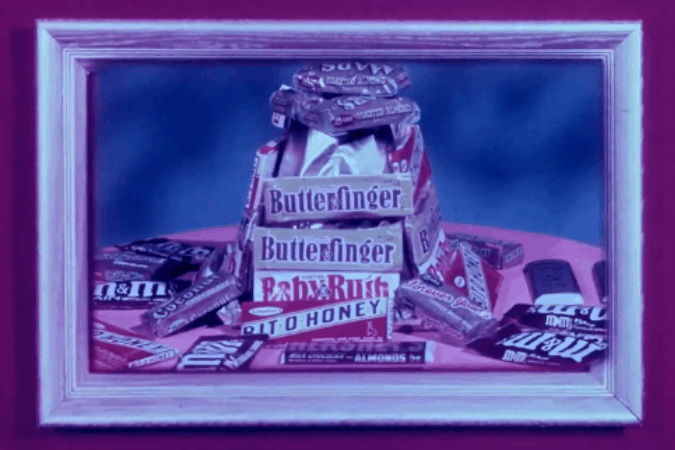
Of course, anecdotally, I know many families have a tradition of purchasing candy at a store before the screening, and then smuggling it into movie theaters that don’t allow outside food or drink. One Michigan man even sued a movie theater over their price gouging (though the lawsuit was allegedly dismissed.) It begs the question, why are movie theater concessions so gosh darn expensive?
You’ve probably heard that movie theaters make most of their money from concessions rather than ticket sales, and there definitely seems to be truth to that.
In part thanks to a supreme court ruling regulating the relationship between studios and movie theaters, film studios take a large percentage of film ticket revenue. By the end of any given film’s run, theaters are left with a mere 20-30% of the gross ticket sales. (I’d imagine it’s sometimes even less, given the percentage is tapered by week, with the first week of a film sending 90%+ of the sales to the studios.)
Cinemas are left with few avenues to stay afloat, let alone gain a profit. For many a multiplex, high-priced concessions are the only choice.
Interestingly, those aforementioned supreme court rulings were recently overturned. Alas, with streaming and television, 2024’s movie distribution landscape is entirely different from Hollywood’s Golden Age, and we likely can’t expect the ticket or concession pricing structures to change anytime soon.
Next up in this series, you can expect:
Alcohol, Beer, Booze, and Soda at the Movies
Cinema Cafes
Drive-In Movie Theater Concessions
and…
The Vast History of Dine-In Movie Theaters
Until then, stay in your seats! (and stay subscribed!)
Disclaimer: Film Flavor is a newsletter written for entertainment purposes only. While I do my best to write meaningful posts with good intentions and cite sources when I have the bandwidth, I do not have the capacity nor the expertise to fact-check research as a trained professional journalist would. Despite my best efforts, the Film Flavor newsletter may contain omissions, errors, or mistakes and cannot be relied upon for accuracy or correctness. Additionally, I am not a chef, doctor, nutritionist, or food professional, and it is the responsibility of the reader to consult qualified professionals and use good judgement to decide whether the ingredients, foods, drinks, recipes, and cooking instructions mentioned within Film Flavor are safe to use, follow, or consume. The Film Flavor newsletter does not contain any professional advice or guidance and its contents should not be considered as such. Read the full Film Flavor disclaimer on the Film Flavor About Page, here. Thank you!
In Case You Missed It….
If you’re interested in more Film Flavor, please consider subscribing and sharing this post with friends and foes via the buttons below!
And please, Leave a Comment and let me know: What is your favorite movie theater candy?
(Vote in the poll above + leave a comment if you don’t see your option listed!)
With gratitude,


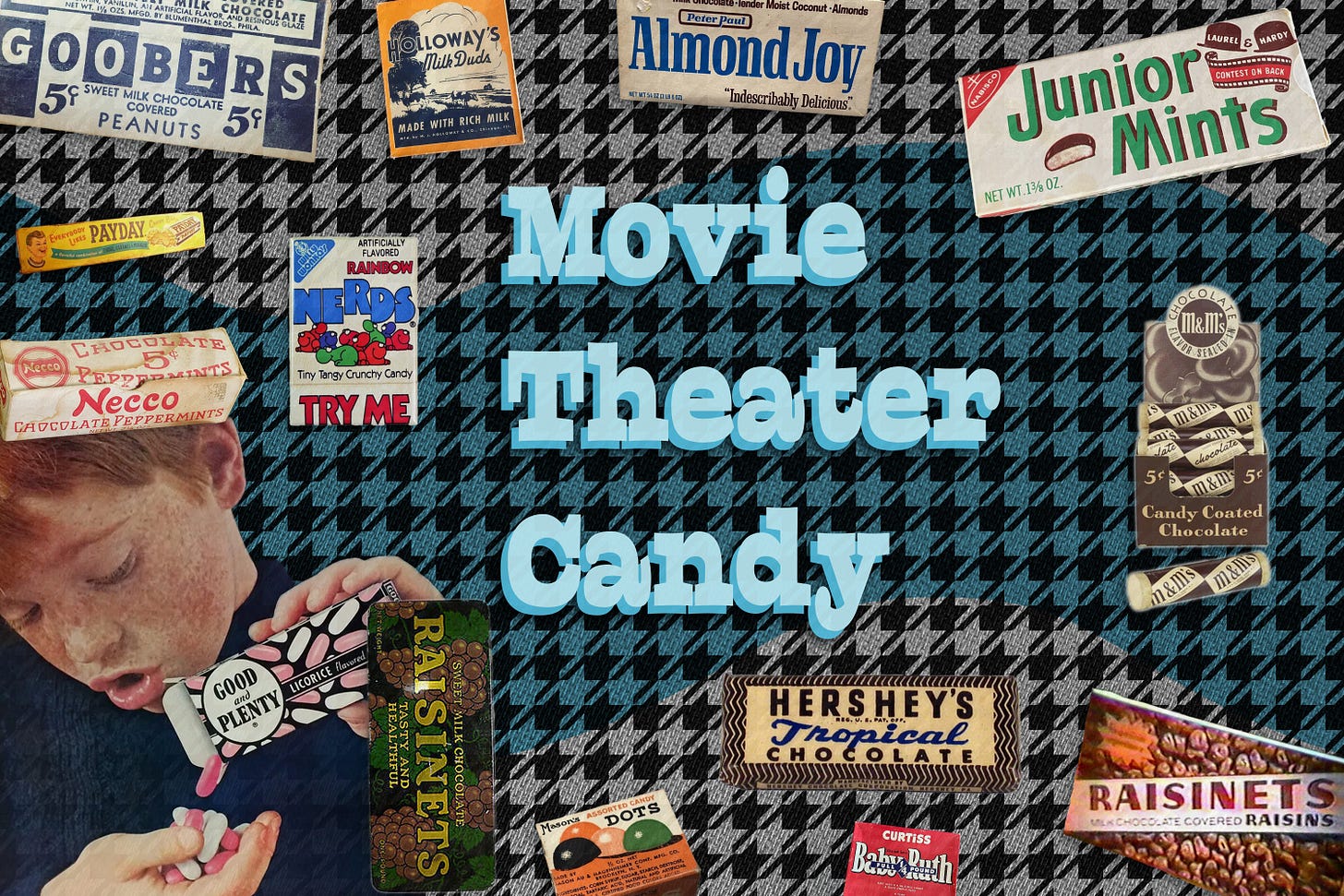

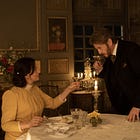

I never thought about noise level being the reasoning behind theater candy boxes! Using this as evidence that Sno-Caps reign supreme
THIS IS SO FUN